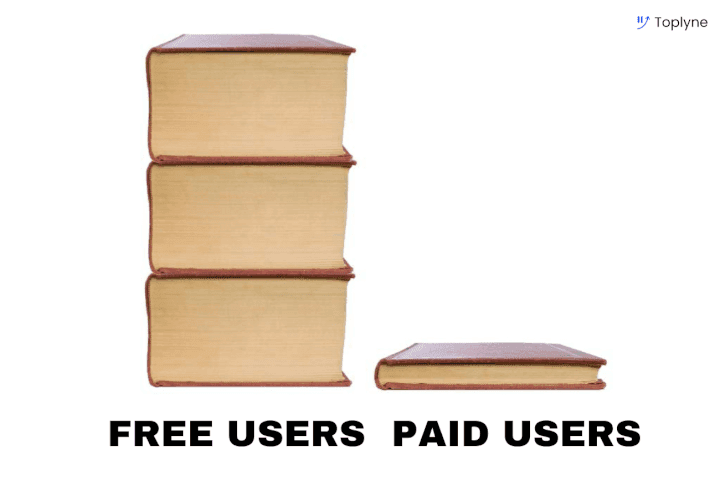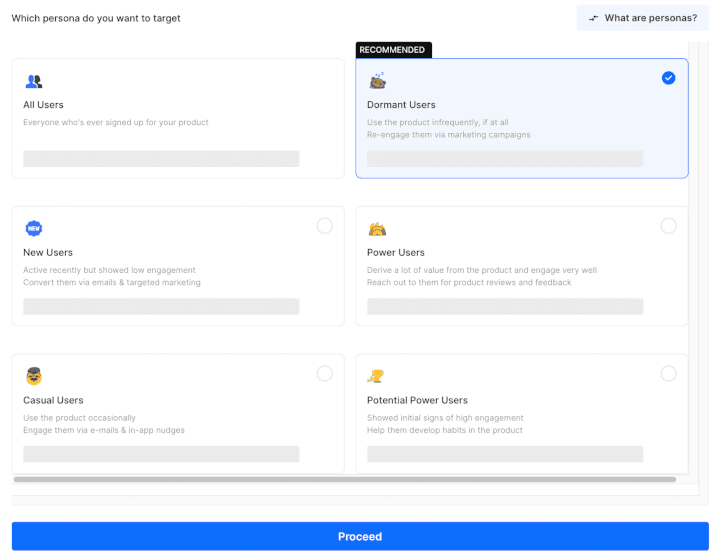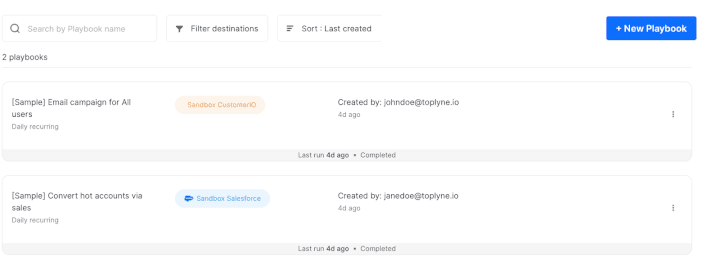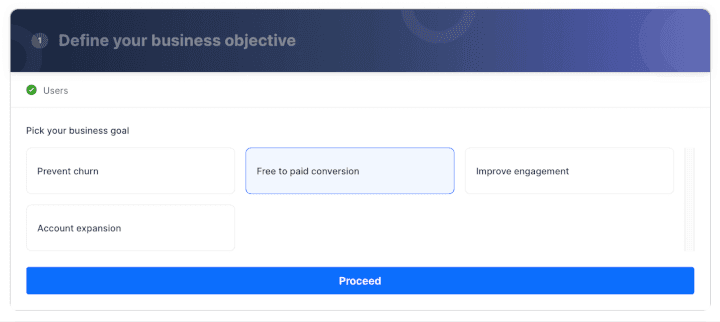7 Surefire Ways to Boost Your Freemium Conversion Rates
7 Surefire Ways to Boost Your Freemium Conversion Rates
7 Surefire Ways to Boost Your Freemium Conversion Rates
Your freemium conversion rate tells you how many free users upgraded to a paid plan. Discover how to boost that figure in this article.
Your freemium conversion rate tells you how many free users upgraded to a paid plan. Discover how to boost that figure in this article.
Your freemium conversion rate tells you how many free users upgraded to a paid plan. Discover how to boost that figure in this article.



The freemium model is an excellent way to attract new users without spending tons on sales and marketing.
But how many of those free users will actually turn into paying customers?

Getting people to try your product for free is easy.
But convincing them to stay and pay — not so much. 😕
We get it – this ain’t no picnic, but there’s no reason to panic!
In this article, we’ll discuss what freemium is and how to calculate freemium conversion rates. We’ll also explore seven awesome ways your SaaS company can improve the freemium pricing strategy.
Finally, we’ll highlight three companies that aced the freemium business model.
Let’s go!
What is Freemium Conversion?
Freemium is a customer acquisition model that lets people use a basic free version of a product forever. Once a free user realizes the product’s value, they can upgrade to a fully-featured premium version and become paid subscribers.
That’s freemium conversion!
Thanks to the low barrier to entry, the freemium business model can help you raise brand awareness. And this increased brand awareness can help you acquire even more users at no additional cost!
To get freemium right, SaaS companies must make the free version attractive enough for a new user to try out. But not so advanced that the customer doesn’t feel the need to upgrade to the premium version.
Sounds like another fancy term for the free trial model?
Think again!
Freemium and free trials are about as similar as sushi 🍣 and paella 🥘.

A freemium user gets free access to basic product features forever, as opposed to a free trial user who can enjoy premium features for a limited time.
But how profitable is your freemium plan?
Let’s find out!
How to Calculate Freemium Conversion Rates

If you have 200 users using the free version of your product, and 8 of them upgrade to the paid plan, your freemium conversion rate is 4%.
Ideally, freemium conversion rates should be between 2-5%.
Not happy with the numbers of your freemium company?
Don’t worry!
We’ll show you how to skyrocket those figures and your business revenue:
Seven Incredible Ways to Boost Your Freemium Conversion Rate
Too many customers jumping ship after trying out your freemium plan?
Here’s how to correct the course:
1. Lock on to the Right Number of “Free” Features
Do you get lots of freemium signups and active users but only a few upgrades to the paid subscription? 😟
News flash: Your freemium offering is too generous!
With ample features in the free plan, you’re leaving your customer with no incentive to upgrade or unlock additional features.
What’s the solution?
Ensure your freemium version showcases your product’s most valuable features but leaves enough of a value gap to push users to invest in your product’s paid subscription.
Monitor product usage data to understand how customers use your product and which features they find most useful.
Offer basic versions of those features in your freemium version and a fully-featured version once they pay.
Why does this work?
These are features they genuinely value, so they won’t mind paying your SaaS company for added functionality!
2. Offer a Comprehensive Free Trial for the Premium Plan
A fully-featured but limited-duration free trial allows every potential customer to use your product in its entirety. It can help you reduce your customer acquisition cost and significantly boost revenue.
How?
When the SaaS free trial ends, the user can either upgrade immediately or opt for the freemium plan.
Pro tip: Ensure the customer doesn’t have to enter their credit card details to use the SaaS free trial. Letting them use your product immediately can boost signups and conversions.
Will this boost your conversion rates?
Hell yeah!
Since your free trial users already know how they can benefit from your product’s paid plan, there’s a higher chance they’ll upgrade immediately.
And when a former trial user chooses the freemium version, they’ll miss all the awesome additional features they had during the SaaS free trial, so they’re more likely to upgrade as well!

3. Pay Close Attention to Customer Onboarding
Creating personalized customer onboarding experiences can work wonders for your freemium conversion rates.
Think personalized welcome pages and emails.
Why?
Personalized onboarding helps you start a dialogue and makes customer relationships less ro-bo-tic. 🤖
It’s also a great opportunity to help freemium users learn your tool through product tours.
But make sure these walkthroughs are exciting and not a snoozefest. 😴
Your user didn’t sign up for a boring documentary!
Further, support users by giving them access to a dedicated customer service team that can address their needs and encourage them to upgrade.
And if a customer is happy with your customer service, they may share their customer success stories with other potential customers.
Finally, don’t force users to enter a ton of information before they can use the product in your freemium pricing model.
No one enjoys filling in lengthy forms!
Here are more tips on how to create a kick-ass product-led onboarding experience.
4. Give Top Users a Sneak Peek of the Premium Features
Use data from tools like Toplyne to identify high-intent freemium users.
Then tease them with the limitless possibilities they can unlock from a premium plan.
Consider sending email notifications about any premium feature that applies to their use case.
Alternatively, prompt users to upgrade once they’ve reached usage limits.
Need an example?
Let’s say your product is a file-sharing app.
Offer limited storage, minimal tool integrations, and collaboration restrictions.
These limitations give your freemium user a preview of what they can gain by becoming paying customers – more storage space, customer support options, integrations, and so on.
You’re indirectly telling your potential premium user, “the world is your oyster!”

5. Leverage CTA Placements
CTAs (call to action) prompt users to perform a specific action.
For your freemium product, CTAs should focus on ONE thing and one thing only:
Encouraging free users to convert to paying customers.
Ensure that your CTA button is well-staged and eye-catching.
Focus on the placement, not just the copy.
Ideally, CTAs should appear near the top of pages where your potential premium user can see it immediately – without having to scroll.
CTAs can also appear in your marketing emails, onboarding videos, support messages, and more.
Tip: Check the effectiveness of your CTA placements by A/B testing different versions.
6. Collect Customer Feedback Routinely
Collecting customer feedback can help you connect with every free user and improve your freemium business model.
It’s also a chance to reconnect with idle freemium users and address the concerns of active users.
Based on this feedback, launch any update or new feature to optimize your freemium business model.
Making improvements based on customer feedback lets users know that their opinions matter, which boosts your conversion rates.
7. Reach Out to High-Quality Leads Directly
Your sales team can give free users that extra nudge they need to upgrade to a paid plan.
They can even help any confused new user realize value before they churn.
How?
Simple. By reaching out to the right customers at the right time!
But how do you identify which users your sales team should reach out to?
With Toplyne!
With this tool, any B2C or B2B product-led growth company can launch unique go-to-market strategies to target freemium customers.
Based on your business objective, Toplyne suggests the following user personas for you to target:
New users: Users who were recently active, but showed low engagement levels (let’s spark up that old flame 🔥).
Casual users: Users who use your product occasionally.
Power users: The most exciting users who use your freemium product often and understand its value. (Talking about every potential paid user here 🤩)
And more

But that’s not all!
Toplyne can also help any freemium company:
Integrate with CRM tools (Salesforce, Hubspot), customer service and engagement platforms (Braze), and product analytics infrastructures (Amplitude, Segment).

Create go-to-market (GTM) playbooks where you combine strategies like in-app nudges, sales assists, remarketing, lifecycle messaging, and more.

Define the business objective or choose a specific goal for your playbook: prevent user churn, free to paid conversion, improve engagement, or account expansion.

Let’s go over a few companies that nailed the freemium business model, improved their customer success strategy, and showed the world how it's done!
Three B2B Companies That Aced the Freemium Model
Here’s the triumphant trio that implemented the freemium business model successfully:
1. Zapier
Zapier lets users seamlessly integrate with different applications and zap ⚡away all their workflow issues.
The limited free version gives users five single-step Zaps. A single-step Zap will allow one trigger (say one new email lead) and only one subsequent action (like adding it to your CRM database).
The premium plan gives the paid user unlimited multi-step Zaps to execute more complex automation tasks.
This freemium business model works like a charm as one single-step Zap demonstrates the power of the product, making users eager to explore the product more.
2. Evernote
Evernote is a great note-taking app for listing anything from product ideas 🗒 to favorite Christmas cookie recipes 🍪.
The free plan lets users:
Create notes up to 25 MB in size.
Sync data across two devices only.
The premium plan allows the paid customer to:
Create notes up to 200 MB in size.
Sync data across unlimited devices.
Add task due dates, reminders, and notifications.
Create recurring tasks and more.
The app shows users how easy it is to take notes and save ideas digitally instead of scribbling words on pieces of paper only to lose it later!

Once they’re used to taking notes on Evernote, they can’t help but opt for the paid version to unlock other essential functionalities.
3. MailChimp
MailChimp is a marketing automation platform that helps you create beautifully designed email campaigns.
And they certainly weren’t monkeying around when they designed their freemium model! 🐒
The free plan lets users:
Send 2,500 monthly emails.
Store 500 contacts.
The premium plan allows the paid customer to:
Send 150,000 monthly emails.
Store unlimited contacts.
Conduct A/B testing for email campaigns.
Their freemium model works because existing users can see how easy email marketing is with MailChimp. And if existing users want to start launching campaigns at scale, they have to upgrade to the paid version.
Track Your Freemium Success with Toplyne
SaaS companies love the freemium model because it can help them widen their user base, decrease the customer acquisition cost, and scale business revenue.
But here’s the deal:
Users will invest their time, energy, and eventually their money in your product only if your product delivers value and solves their unique problems.
Stay ahead of your competitors by choosing a platform like Toplyne to spot high-intent freemium users and get them to convert in a jiffy!
Ready to level up your freemium game?
Sign up for Toplyne for free today to take your users from freemium to premium like a pro!

The freemium model is an excellent way to attract new users without spending tons on sales and marketing.
But how many of those free users will actually turn into paying customers?

Getting people to try your product for free is easy.
But convincing them to stay and pay — not so much. 😕
We get it – this ain’t no picnic, but there’s no reason to panic!
In this article, we’ll discuss what freemium is and how to calculate freemium conversion rates. We’ll also explore seven awesome ways your SaaS company can improve the freemium pricing strategy.
Finally, we’ll highlight three companies that aced the freemium business model.
Let’s go!
What is Freemium Conversion?
Freemium is a customer acquisition model that lets people use a basic free version of a product forever. Once a free user realizes the product’s value, they can upgrade to a fully-featured premium version and become paid subscribers.
That’s freemium conversion!
Thanks to the low barrier to entry, the freemium business model can help you raise brand awareness. And this increased brand awareness can help you acquire even more users at no additional cost!
To get freemium right, SaaS companies must make the free version attractive enough for a new user to try out. But not so advanced that the customer doesn’t feel the need to upgrade to the premium version.
Sounds like another fancy term for the free trial model?
Think again!
Freemium and free trials are about as similar as sushi 🍣 and paella 🥘.

A freemium user gets free access to basic product features forever, as opposed to a free trial user who can enjoy premium features for a limited time.
But how profitable is your freemium plan?
Let’s find out!
How to Calculate Freemium Conversion Rates

If you have 200 users using the free version of your product, and 8 of them upgrade to the paid plan, your freemium conversion rate is 4%.
Ideally, freemium conversion rates should be between 2-5%.
Not happy with the numbers of your freemium company?
Don’t worry!
We’ll show you how to skyrocket those figures and your business revenue:
Seven Incredible Ways to Boost Your Freemium Conversion Rate
Too many customers jumping ship after trying out your freemium plan?
Here’s how to correct the course:
1. Lock on to the Right Number of “Free” Features
Do you get lots of freemium signups and active users but only a few upgrades to the paid subscription? 😟
News flash: Your freemium offering is too generous!
With ample features in the free plan, you’re leaving your customer with no incentive to upgrade or unlock additional features.
What’s the solution?
Ensure your freemium version showcases your product’s most valuable features but leaves enough of a value gap to push users to invest in your product’s paid subscription.
Monitor product usage data to understand how customers use your product and which features they find most useful.
Offer basic versions of those features in your freemium version and a fully-featured version once they pay.
Why does this work?
These are features they genuinely value, so they won’t mind paying your SaaS company for added functionality!
2. Offer a Comprehensive Free Trial for the Premium Plan
A fully-featured but limited-duration free trial allows every potential customer to use your product in its entirety. It can help you reduce your customer acquisition cost and significantly boost revenue.
How?
When the SaaS free trial ends, the user can either upgrade immediately or opt for the freemium plan.
Pro tip: Ensure the customer doesn’t have to enter their credit card details to use the SaaS free trial. Letting them use your product immediately can boost signups and conversions.
Will this boost your conversion rates?
Hell yeah!
Since your free trial users already know how they can benefit from your product’s paid plan, there’s a higher chance they’ll upgrade immediately.
And when a former trial user chooses the freemium version, they’ll miss all the awesome additional features they had during the SaaS free trial, so they’re more likely to upgrade as well!

3. Pay Close Attention to Customer Onboarding
Creating personalized customer onboarding experiences can work wonders for your freemium conversion rates.
Think personalized welcome pages and emails.
Why?
Personalized onboarding helps you start a dialogue and makes customer relationships less ro-bo-tic. 🤖
It’s also a great opportunity to help freemium users learn your tool through product tours.
But make sure these walkthroughs are exciting and not a snoozefest. 😴
Your user didn’t sign up for a boring documentary!
Further, support users by giving them access to a dedicated customer service team that can address their needs and encourage them to upgrade.
And if a customer is happy with your customer service, they may share their customer success stories with other potential customers.
Finally, don’t force users to enter a ton of information before they can use the product in your freemium pricing model.
No one enjoys filling in lengthy forms!
Here are more tips on how to create a kick-ass product-led onboarding experience.
4. Give Top Users a Sneak Peek of the Premium Features
Use data from tools like Toplyne to identify high-intent freemium users.
Then tease them with the limitless possibilities they can unlock from a premium plan.
Consider sending email notifications about any premium feature that applies to their use case.
Alternatively, prompt users to upgrade once they’ve reached usage limits.
Need an example?
Let’s say your product is a file-sharing app.
Offer limited storage, minimal tool integrations, and collaboration restrictions.
These limitations give your freemium user a preview of what they can gain by becoming paying customers – more storage space, customer support options, integrations, and so on.
You’re indirectly telling your potential premium user, “the world is your oyster!”

5. Leverage CTA Placements
CTAs (call to action) prompt users to perform a specific action.
For your freemium product, CTAs should focus on ONE thing and one thing only:
Encouraging free users to convert to paying customers.
Ensure that your CTA button is well-staged and eye-catching.
Focus on the placement, not just the copy.
Ideally, CTAs should appear near the top of pages where your potential premium user can see it immediately – without having to scroll.
CTAs can also appear in your marketing emails, onboarding videos, support messages, and more.
Tip: Check the effectiveness of your CTA placements by A/B testing different versions.
6. Collect Customer Feedback Routinely
Collecting customer feedback can help you connect with every free user and improve your freemium business model.
It’s also a chance to reconnect with idle freemium users and address the concerns of active users.
Based on this feedback, launch any update or new feature to optimize your freemium business model.
Making improvements based on customer feedback lets users know that their opinions matter, which boosts your conversion rates.
7. Reach Out to High-Quality Leads Directly
Your sales team can give free users that extra nudge they need to upgrade to a paid plan.
They can even help any confused new user realize value before they churn.
How?
Simple. By reaching out to the right customers at the right time!
But how do you identify which users your sales team should reach out to?
With Toplyne!
With this tool, any B2C or B2B product-led growth company can launch unique go-to-market strategies to target freemium customers.
Based on your business objective, Toplyne suggests the following user personas for you to target:
New users: Users who were recently active, but showed low engagement levels (let’s spark up that old flame 🔥).
Casual users: Users who use your product occasionally.
Power users: The most exciting users who use your freemium product often and understand its value. (Talking about every potential paid user here 🤩)
And more

But that’s not all!
Toplyne can also help any freemium company:
Integrate with CRM tools (Salesforce, Hubspot), customer service and engagement platforms (Braze), and product analytics infrastructures (Amplitude, Segment).

Create go-to-market (GTM) playbooks where you combine strategies like in-app nudges, sales assists, remarketing, lifecycle messaging, and more.

Define the business objective or choose a specific goal for your playbook: prevent user churn, free to paid conversion, improve engagement, or account expansion.

Let’s go over a few companies that nailed the freemium business model, improved their customer success strategy, and showed the world how it's done!
Three B2B Companies That Aced the Freemium Model
Here’s the triumphant trio that implemented the freemium business model successfully:
1. Zapier
Zapier lets users seamlessly integrate with different applications and zap ⚡away all their workflow issues.
The limited free version gives users five single-step Zaps. A single-step Zap will allow one trigger (say one new email lead) and only one subsequent action (like adding it to your CRM database).
The premium plan gives the paid user unlimited multi-step Zaps to execute more complex automation tasks.
This freemium business model works like a charm as one single-step Zap demonstrates the power of the product, making users eager to explore the product more.
2. Evernote
Evernote is a great note-taking app for listing anything from product ideas 🗒 to favorite Christmas cookie recipes 🍪.
The free plan lets users:
Create notes up to 25 MB in size.
Sync data across two devices only.
The premium plan allows the paid customer to:
Create notes up to 200 MB in size.
Sync data across unlimited devices.
Add task due dates, reminders, and notifications.
Create recurring tasks and more.
The app shows users how easy it is to take notes and save ideas digitally instead of scribbling words on pieces of paper only to lose it later!

Once they’re used to taking notes on Evernote, they can’t help but opt for the paid version to unlock other essential functionalities.
3. MailChimp
MailChimp is a marketing automation platform that helps you create beautifully designed email campaigns.
And they certainly weren’t monkeying around when they designed their freemium model! 🐒
The free plan lets users:
Send 2,500 monthly emails.
Store 500 contacts.
The premium plan allows the paid customer to:
Send 150,000 monthly emails.
Store unlimited contacts.
Conduct A/B testing for email campaigns.
Their freemium model works because existing users can see how easy email marketing is with MailChimp. And if existing users want to start launching campaigns at scale, they have to upgrade to the paid version.
Track Your Freemium Success with Toplyne
SaaS companies love the freemium model because it can help them widen their user base, decrease the customer acquisition cost, and scale business revenue.
But here’s the deal:
Users will invest their time, energy, and eventually their money in your product only if your product delivers value and solves their unique problems.
Stay ahead of your competitors by choosing a platform like Toplyne to spot high-intent freemium users and get them to convert in a jiffy!
Ready to level up your freemium game?
Sign up for Toplyne for free today to take your users from freemium to premium like a pro!

Related Articles




Behavioral Retargeting: A Game-Changer in the Cookieless Era
Unlock the power of behavioral retargeting for the cookieless future! Learn how it personalizes ads & boosts conversions. #behavioralretargeting




All of Toplyne's 40+ Badges in the G2 Spring Reports
Our customers awarded us 40+ badges in G2's Summer Report 2024.




Unlocking the Full Potential of Google PMax Campaigns: Mastering Audience Selection to Double Your ROAS
Copyright © Toplyne Labs PTE Ltd. 2024
Copyright © Toplyne Labs PTE Ltd. 2024
Copyright © Toplyne Labs PTE Ltd. 2024
Copyright © Toplyne Labs PTE Ltd. 2024